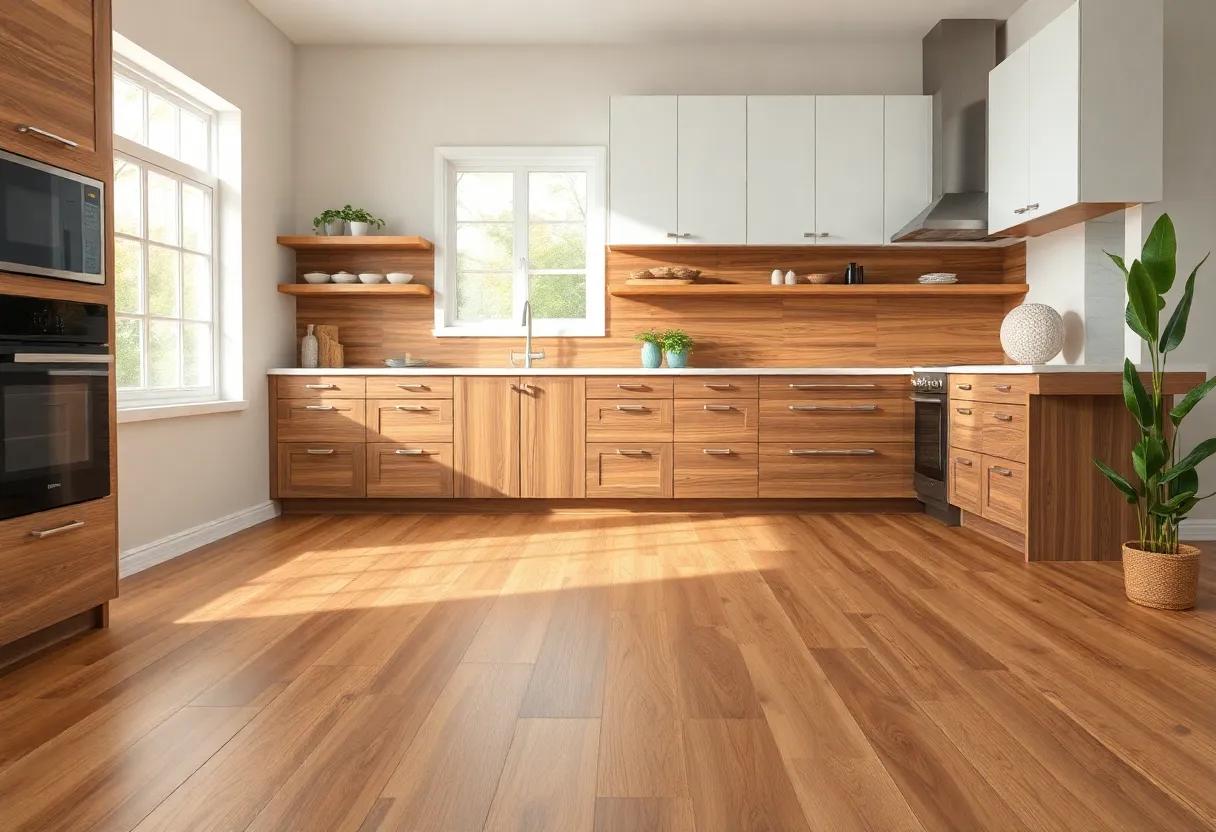Durable and Stylish: Exploring the Best Kitchen Flooring Choices for Your Home
Choosing the right kitchen flooring choices can significantly impact the functionality and aesthetics of your home. With varied options available—each boasting its own unique features—it’s essential to evaluate them based on durability, style, and maintenance requirements. This guide aims to explore some of the best kitchen flooring choices, offering insights into their advantages and potential drawbacks.
1. Hardwood Flooring
Hardwood flooring remains a popular choice for many homeowners due to its timeless beauty and durability. Most hardwoods come in both solid and engineered varieties, allowing flexibility in design and budget.
Advantages
- Durability: Quality hardwood can last decades when properly maintained.
- Style: Available in various species, grain patterns, and finishes, hardwood flooring complements diverse design styles.
- Resale Value: Homes with hardwood floors often see a higher resale value.
Considerations
- Moisture Sensitivity: Hardwood can warp or stain easily in a high-moisture environment.
- Cost: Installation and materials can be expensive compared to other options.
2. Laminate Flooring
Laminate flooring mimics the appearance of wood or tile but comes at a fraction of the cost. It is constructed with a high-density fiberboard core and a photographic layer that provides a realistic look.
Advantages
- Affordability: Laminate is one of the most budget-friendly kitchen flooring choices.
- Scratch Resistance: Modern laminates are designed to resist scratches and stains effectively.
- Easy Installation: Plank-style laminate allows for simple installation as a DIY project.
Considerations
- Noise Level: Laminate can be noisier than hardwood or tile, especially when walked on.
- Less Resale Value: It may not add as much value to your home compared to real wood.
3. Vinyl Flooring
Vinyl flooring has evolved significantly over the years, offering both luxury and affordability. Rigid core vinyl planks and traditional sheet vinyl provide homeowners with versatile options.
Advantages
- Water Resistance: Vinyl is highly resistant to moisture, making it ideal for kitchen environments.
- Variety: Available in countless colors and patterns, it can mimic wood, stone, and tile.
- Comfort: Softer underfoot than tile or hardwood, vinyl provides comfort, especially for prolonged standing.
Considerations
- Durability: While decent, it may not be as long-lasting as laminate or hardwood under heavy traffic.
- Environmental Concerns: Some types of vinyl are made from PVC, which can raise environmental questions.
4. Tile Flooring
Tile flooring offers robust durability and versatility, especially in moisture-prone areas like kitchens. Ceramic, porcelain, and natural stone tiles each have unique qualities that cater to different needs.
Advantages
- Longevity: Tile is incredibly durable and can withstand heavy foot traffic with ease.
- Waterproof: Perfect for kitchens due to its excellent moisture resistance.
- Design Flexibility: Available in myriad colors, patterns, and finishes, tiles can fit any aesthetic preference.
Considerations
- Cold Surface: Tile can be cold underfoot, which may be uncomfortable in colder climates.
- Grout Maintenance: Grout lines can stain and require regular cleaning and maintenance.
5. Cork Flooring
Cork flooring is an eco-friendly option that is becoming increasingly popular. It is harvested from the bark of cork oak trees, making it a renewable resource.
Advantages
- Comfort: The cushioning nature of cork provides comfort, reducing fatigue from standing.
- Insulation: Cork is a natural insulator, keeping space warm and providing sound insulation.
Considerations
- Sensitivity to Moisture: While it is moisture-resistant, prolonged exposure can lead to damage.
- Fading: Sunlight can fade cork flooring over time if not properly treated.
6. Bamboo Flooring
Bamboo flooring, derived from the fast-growing bamboo grass, offers a stylish alternative to traditional hardwood. It’s known for its sustainability, making it an eco-conscious choice.
Advantages
- Durability: Bamboo is tough and resistant to wear, making it suitable for high-traffic areas.
- Style: Bamboo has a modern aesthetic that fits well in various design themes.
Considerations
- Moisture Susceptibility: Similar to hardwood, bamboo can warp in humid environments.
- Limited Styles: The variety in patterns and color may not be as extensive as other flooring options.
7. Rubber Flooring
Rubber flooring is an uncommon yet effective kitchen flooring choice. Often used in commercial settings, rubber’s versatility is gaining traction in residential kitchens.
Advantages
- Durability: Highly resilient and can withstand heavy foot traffic and wear.
- Slip Resistance: Provides excellent traction, reducing the risk of slips and falls.
- Ease of Cleaning: Non-porous and easy to maintain; just a mop and mild detergent are sufficient.
Considerations
- Aesthetic Appeal: The look may not suit all style preferences, often considered too utilitarian.
- Potential Odor: Some rubber flooring options may have a strong odor initially.
Conclusion
When selecting the right flooring for your kitchen, consider factors such as durability, maintenance, style, and comfort. Each of the explored kitchen flooring choices offers unique advantages that can complement your home’s design while providing functionality. Take time to assess your lifestyle, preferences, and budget before making a decision. By doing so, you can achieve a kitchen space that is both durable and stylish.
Author: STAFF HERE NOVI WRITER
The NOVI STAFF WRITER represents the experienced team at HERENovi.com, your go-to source for actionable local news and information in Novi, Oakland County, and beyond. Specializing in "news you can use," we cover essential topics like product reviews for personal and business needs, local business directories, politics, real estate trends, neighborhood insights, and state news affecting the area—with deep expertise drawn from years of dedicated reporting and strong community input, including local press releases and business updates. We deliver top reporting on high-value events such as Motor City Comic Con, Michigan State Fair, and Novi Home and Garden Show. Our coverage extends to key organizations like the Novi Chamber of Commerce and Novi Community Foundation, plus leading businesses in automotive, technology, and manufacturing that power the local economy such as Gentherm, Stoneridge, and Daifuku North America. As part of the broader HERE network, including HEREDetroitMI.com, HEREGrandRapids.com, HERENorthville.com, and HEREPlymouth.com, we provide comprehensive, credible insights into Michigan's dynamic landscape.







